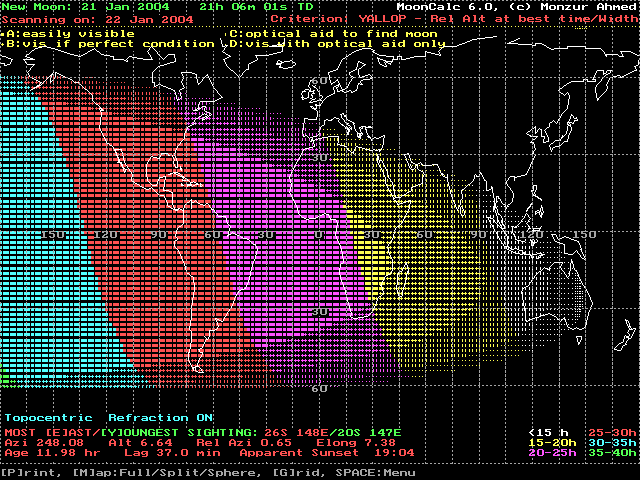
Visibility of Thul Hijjah Crescent
(1424 AH)

- When to Observe ?
- Results of Observation
- The First Day in Different Countries
- The Accuracy of The Astronomical Calculations.
The geocentric new Moon will occur Inshalla on Tuesday (21 January 2004), at
21:05 UT.On this day (Tuesday 21 January 2004), it is not possible to see the crescent from anywhere on Earth.
While on the next day the program Moon
Calculator by Dr. Monzur Ahmed -according to Yallop criterion- showed that it is possible to
see the crescent by optical aid from Australia, South East Asia, India, Arabian Peninsula and North part
of Africa. and by naked eyes from the rest of Africa and the American Continents.
According to the actual sighting of the crescent, the start of Thul Hijjah should be on
Friday 23 January 2004 in most of the countries.
- Results of seeing the crescent, and the first day of the month in different countries will be added here Inshalla as we receive the reports from ICOP's members. If you wish to be a member in ICOP, or to know more about it, kindly click here.
So far, the earliest sighting of the crescent was on Thursday 22 January 2004
from Iran by ICOP member Mr. Alireza Mehrani.
Thursday 22 January 2004:
After three times of failure in observing the April 2, 2003 evening crescent, June 29, 2003 and August 27, 2003 morning crescent due to unsuitable weather condition, the successful observation of October 26, 2003 (Ramadan 1424) improved, to some extent, hopelessness of these failures. What could complete my total trial in observing the crescent was the trail to observe the evening crescent on January 22nd, 2004.
After observing the Ramadan crescent I began to study this crescent. My purpose in this observation is to retest the criterions of Yallop and SAAO.
Since January 12th I regularly have controlled the weather forecast reports. In order to do this observation I had to go from Esfahan to the south or South-East of the country. Therefore, I had to be precise in selecting the observing location and the weather condition of the area. All these caused me to select Kerman State for this purpose. Kerman is located at 650 km east of Esfahan. In order to do this observation we used the following equipment:
At midnight of January 21st we started for Kerman and were at the destination after seven hours. The place of observation is called Bardsir city (55 km South-West of Kerman). Weather condition in this place was extraordinary for the purpose. Raining of the days earlier had made the weather totally free from dust.
I used 15x80 binoculars having fixed it on a tripod. I got the azimuth of the sun during the sunset using the Moon Calculator software, as well as that of the crescent for 17:24. The difference of the two was 5.5 degree. I also used a 7x50 binoculars equipped with a compass. At the moment of the sunset I saw the location of the sunset with this binocular; and then I shifted 5.5 degree towards the left, of course, using the compass of the binoculars. At that point, I determined an index on the horizon and zoomed the 15x80 binoculars to the point.
The sunset was 17:09 (LT); and the altitude of mountain in the west horizon was about 0.2 degree. I began to search for the crescent at 17:20. After about three minutes, I felt I was able to see vague signs of the crescent. I focused more at the point and it was at 17:24 when I clearly saw the crescent.
The other five accompanying persons, too, succeeded in observing the crescent. I also could observe the crescent using the 27x150 binoculars. The very high quality of the binoculars caused me to see more details about the crescent. The crescent was in one piece, the length of the arc being 105 degree. If I had used these binoculars, I could have definitely observed the crescent much sooner. A friend of mine settled his shooting camera behind the 20x120 binoculars and did the filming of the crescent.
The suitable weather condition made it possible to observe the crescent till the moonset.
Friday 23 January 2004 : -
Saturday 24 January 2004 :-
To know about the accuracy of the astronomical calculations, then please click here

When to Observe ?


Results of Observation
Friday 23 January 2004:




The OFFICIAL First Day in Different Countries

The Accuracy of The Astronomical Calculations





